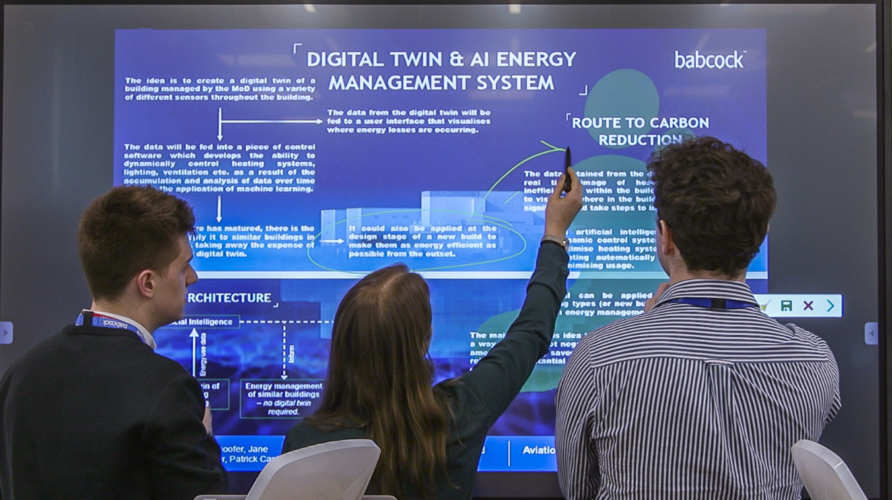This is the third year Babcock has supported the Collaborate to Innovate Awards and I’m delighted we’re supporting an event that brings together so many innovative projects that have the potential to make a real impact on society.
I consider myself lucky that as Babcock’s Chief Innovation and Technology Officer I work with people that drive and deliver innovation every day, using technology to build a better future for the world we live in. One of the reasons we support programmes like this is because of the way it unites technologists, academia and industry and encourages them to think differently, to collaborate, to create and innovate.
And it’s the strength of the people and the organisations we partner with that really makes a difference to the work Babcock does; whether that’s in defence, emergency services, our nuclear or our training businesses.
So despite the sheer enormity, pace and scale of change COVID-19 gave us in 2020, I have never before been so inspired by how our people responded. Last March, when we were tasked by the UK Prime Minister to design and build a ventilator from scratch, we put any limitations to one side and focused on what we had: engineering ingenuity, technology innovation, successful partnerships and a small team of incredible people. That team put themselves under huge pressure to create a solution, and they delivered. Within seven days we had a working prototype. In all, we collaborated with over 40 suppliers.
As a technology-led company, the assets we manage are complex and critical, ranging from warships to nuclear power stations - and increasingly our customers are turning to us to answer their technology challenges. We know that as well as mature technologies, we need to be aware of emerging ones, so we can apply appropriate solutions that will prolong the life of these assets, which sometimes have a lifecycle of 60 years and beyond.
Digital Technology
The pace of change in digital technology means collaboration is fundamental for us and the wider industry: it benefits our customers too. It’s not enough to just have the latest bit of kit or application, we need people that understand the increasingly complex data world we are in; people who can translate and transform that data to bring about real, tangible benefits to how we look after those assets.

We apply this thinking across our whole asset lifecycle to new and existing platforms or equipment. That includes digitisation of the asset and coherence of design and support data to form a digital thread. This digital thread provides a fully integrated view of the asset's data throughout its lifecycle, which can be shared across all stakeholders operating and managing the asset. We use digital twins to exploit that information to provide an accurate representation of a variety of physical systems. Adopting advanced analytical techniques such as machine learning and AI together with our technical and engineering expertise to model behaviours, predict outcomes and ultimately enable high quality data-driven decision making.
In my capacity as Chair of Team Defence Information we’ve been collaborating with over 60 industry players and supporting the National Digital Twin programme, to initiate and develop a digital twin roadmap.
Working in partnership with our customers and original equipment manufacturers we are implementing similar programmes across a number of existing assets that Babcock supports or operates, including the UK Royal Navy’s Type 23 frigates, UK Army platforms such as Bulldog and Jackal, military aviation platforms and infrastructure, civil aircraft and civil nuclear power plants. We are also putting this digital approach at the core of new platform development such as the Type 31 frigate class and the Dreadnought nuclear submarine programme where we are working with our supply chain to establish a digital thread at the design stage which can live with the platform throughout its life-cycle.
We are also engaged in a number of research activities to drive innovation and inform our technology roadmap, these include the Advanced Nuclear Research Centre and the Advanced Manufacturing Research Centre as well as academic organisations such as Universities of Cranfield, Strathclyde and Exeter.
Innovation through Collaboration
We’re supporting a number of MSc projects through our partnership at Cranfield, examining industrial implementation of ontology-based augmented reality and digital twins, through to data management for asset maintenance. With the University of Edinburgh we are building FASTBLADE, the world’s first full-scale international composite test centre which will have a state-of-the-art research facility onsite. Cutting-edge digital and hydraulic systems developed by the university will be more energy efficient than existing processes and will simulate real operating environments. The complexity of the data that will be generated again means we will need different skills. So working with the University of Edinburgh we have initiated PhD level research in Asset Management of Composites to support the project.
More widely, Babcock’s focus on sustainability and our people means we are creating a workforce that can solve problems as they arise, and understand the importance of sustainable technology.
Our apprentices and graduates are a key part of our future and I am looking forward to celebrating their stories as part of National Apprenticeship Week next week.
I am inspired by our people every day, because innovation isn’t just in that cutting-edge piece of technology, it’s in our people and how they apply it; it’s in our partnerships – it’s in what we deliver and it defines not just who we are but what we can be – and that’s what I am looking forward to.
Congratulations to all the winners of this year’s Collaborate to Innovate Awards from Babcock.




Project to investigate hybrid approach to titanium manufacturing
What is this a hybrid of? Superplastic forming tends to be performed slowly as otherwise the behaviour is the hot creep that typifies hot...